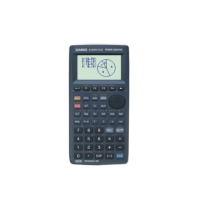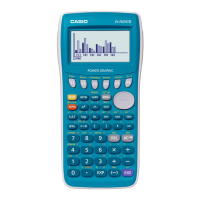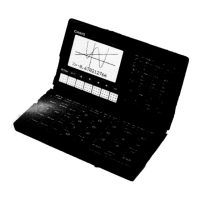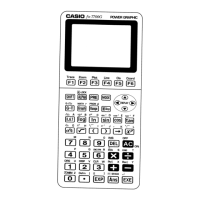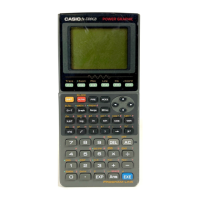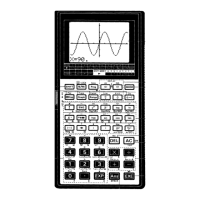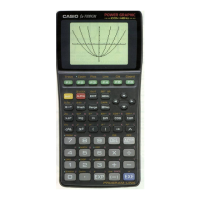Do you have a question about the Casio fx-7450G and is the answer not in the manual?
| Brand | Casio |
|---|---|
| Model | fx-7450G |
| Category | Calculator |
| Language | English |
Instructions for initial setup and first-time use of the calculator.
Important information regarding FCC regulations and equipment compliance.
A note to keep the manual for future reference.
Essential advice for maintaining the calculator's performance and longevity.
Explains how to navigate and use the calculator's main menu options.
Details the function and location of the calculator's keys and their labels.
Explains how to use the Alpha lock function for inputting characters.
Explains the color coding and markings on the calculator keys for easier identification.
Guides the user on how to select different operational modes using the Set Up screen.
Details the various display screens and their functions, including text and graph displays.
Explains how to format numbers in exponential notation and manage the display range.
Describes the screen shown during calculation execution, including error indicators.
Instructions on how to adjust the display contrast for better readability.
Covers basic arithmetic operations of addition and subtraction with examples.
Explains how to perform multiplication operations on the calculator.
Details the process of performing division calculations.
Explains how to perform division that yields both a quotient and a remainder.
Covers calculations involving multiple operations and the order of execution.
Explains the order of operations in mixed calculations.
How to input and handle negative numbers in calculations.
How to input and calculate exponential expressions.
How to round calculation results to a specified number of decimal places.
Introduces advanced calculation features beyond basic arithmetic.
How to use the Ans memory to recall the previous calculation result.
Performing subsequent calculations using the previous result.
How to recover from calculation errors and interpret error messages.
Steps for editing and correcting calculation entries.
How to assign and use variables in calculations.
How to input and display fractions in various formats.
Steps for performing arithmetic operations with fractions.
How to set the calculator's mode for automatic fraction simplification.
How to choose display formats like fixed decimal places or scientific notation.
Setting the number of decimal places for display.
Setting the number of significant digits for display.
Setting the range for exponential number display.
Introduces calculations using trigonometric and other scientific functions.
Performing calculations with trigonometric functions like sine, cosine, and tangent.
Covers other scientific functions like logarithms, powers, and absolute values.
Converting between rectangular and polar coordinates.
Calculating permutations and combinations.
General tips and reminders related to calculations.
Details the order of operations in complex calculations.
Explains the concept of calculation stacks and their usage.
Information on checking and understanding memory usage.
Using commands to display calculation results.
Combining multiple commands into a single statement.
How to check the memory status and available memory for different data types.
Procedures for clearing specific data or all data from memory.
Accessing and using the variable data menu.
Setting up the display window parameters for graphs.
Restoring previously saved view window settings.
Storing and recalling view window configurations.
Resetting view window parameters to default values.
Selecting the default unit (degrees, radians, grads) for angle calculations.
Performing conversions between different angle units.
Steps for calculating the differential of a function at a specific point.
Preparatory steps before creating a graph, including mode selection.
How to access and start the graphing mode.
Setting the display range and scale for the graph axes.
Entering numerical values for graph window parameters.
Storing and recalling view window settings.
Resetting view window parameters to default values.
How to input, store, and manage functions for graphing.
Selecting the type of graph (e.g., rectangular, parametric).
Saving a function expression into memory for graphing.
Storing inequality expressions for graphical representation.
Modifying or deleting stored graph functions.
Removing a stored function from memory.
The process of generating and displaying a graph on the screen.
Creating graphs by plotting points or drawing lines manually.
Plotting functions in the standard rectangular coordinate system.
Plotting functions defined by parametric equations.
Visualizing inequality expressions on the graph.
Additional functions for graph manipulation and analysis.
Moving a cursor along a graph to view coordinate values.
Steps for using the trace feature to find points of interest.
Moving the graph display horizontally or vertically.
Enlarging or reducing the graph display for better detail.
Preparations before applying zoom functions.
Selecting a specific area of the graph to zoom into.
Zooming using predefined magnification factors.
Drawing graphs based on stored functions or data.
Initial steps before using the sketch function.
Manually adding points to a graph.
Connecting plotted points with a line segment.
Drawing vertical lines through specified points on a graph.
Connecting specific points on a curve with tangent lines.
Drawing vertical lines on the graph.
Drawing horizontal lines on the graph.
Removing drawn elements from the graph.
Using the calculator to generate numeric tables and graphs from functions.
Saving a function expression for use in tables or graphs.
Removing a stored function from memory.
Setting values for variables used in functions.
Creating a table of function values for a range of inputs.
Modifying the contents of a generated numeric table.
Displaying a graphical representation of a function.
Managing and using lists for data storage and calculations.
Basic operations for manipulating data within lists.
Entering data into a list cell by cell.
Entering multiple values into a list efficiently.
Removing a specific data entry from a list.
Clearing all data from a list.
Modifying existing values within a list.
Updating the value of a single cell in a list.
Adding a new empty cell to a list.
Arranging list data in ascending or descending order.
Sorting the data in one list.
Performing operations on list data like counting, summing, etc.
Finding out how many data items are in a list.
Identifying the smallest value in a list.
Identifying the largest value in a list.
Computing the average value of data in a list.
Finding the middle value in a sorted list.
Adding up all the values in a list.
Performing calculations using list data and numeric values.
Entering a value into a specific cell within a list.
Displaying the data stored in a list.
Using list data in calculations stored in Ans Memory.
Plotting functions that utilize list data.
Performing scientific calculations with data from lists.
Preparation steps before conducting statistical analysis.
Demonstrations of various statistical calculations with examples.
Entering data into lists for statistical analysis.
Visualizing data points on various types of graphs.
Creating a scatter plot to show the relationship between two variables.
Configuring general display settings for graphs.
Choosing the area for statistical graph settings.
Choosing the specific type of graph to display.
Assigning a list as the source for x-axis data.
Assigning a list as the source for y-axis data.
Assigning a list for frequency data in statistical plots.
Viewing the results of statistical calculations.
Visualizing calculation results, such as regression formulas.
Showing statistical measures for a single dataset.
Performing calculations and plotting data for single variables.
Creating a bar chart to represent data frequency.
Generating a box plot to visualize data distribution.
Plotting a curve representing a normal distribution.
Performing analysis and graphing for datasets with two variables.
Plotting a line of best fit for paired data.
Displaying a median-median line graph.
Plotting a curve for quadratic regression analysis.
Displaying a graph based on power regression.
Viewing the results of paired-variable statistical analysis.
Creating graphs by manually inputting data and settings.
Adjusting the width of sigma bars in histograms.
Steps to input data and generate a graph.
Choosing the specific type of graph to be displayed.
Adding individual data points to a graph.
Introduction to programming and its concepts on the calculator.
Illustrative examples of programs and their creation.
Assigning a name to a program file.
Entering program code line by line.
Switching between different modes while programming.
Executing a stored program.
Identifying and fixing errors within a program.
Determining the memory space a program occupies.
Accessing and using the calculator's secret function.
Saving a program with password protection.
Locating specific program files.
Searching for a program by its exact name.
Searching for programs based on starting characters.
Modifying the code of an existing program.
Steps to make changes to a program's code.
Removing programs from the calculator's memory.
Removing a single program.
Erasing all stored programs.
Overview of commands used in program logic and control.
Accessing commands related to program flow and execution.
Commands for controlling program execution flow.
Commands for clearing screen or list data.
Commands for displaying text or graphs.
Relational operators used in conditional program jumps.
Executing commands based on a condition.
Executing different commands based on condition truthiness.
Creating loops that repeat a block of code a specified number of times.
Loops that increment by a specified step value.
Loops that repeat as long as a condition remains true.
Loops that execute while a specified condition is met.
Command to execute a subroutine or another program.
Commands for unconditional jumps to specified labels.
Commands used for jumping to different parts of a program.
Conditional command for program flow control.
Command to clear the graph display.
Command to clear the text display.
Command to draw a graph based on stored functions.
Commands for inputting and outputting data.
Command to send data to an external device.
Relational operators used in conditional program jumps.
Incorporating table and graph functions within programs.
Sorting lists within program execution.
Sorting list data in increasing order.
Sorting list data in decreasing order.
Performing statistical operations and graphing within programs.
Configuring settings for drawing statistical graphs.
Executing statistical calculations using program logic.
Performing statistical analysis on a single dataset.
Performing statistical analysis on datasets with two variables.
Performing various types of regression analysis.
Calculating a linear regression model.
Displaying a median-median line graph.
Performing quadratic regression analysis.
Performing logarithmic regression analysis.
Performing power regression analysis.
Procedures for linking two calculator units.
Steps to connect the calculator to a PC for data transfer.
Connecting the calculator to a label printer.
Preparations before initiating data transfer.
Detailed steps for sending and receiving data.
Instructions for the unit sending data.
Instructions for the unit receiving data.
Choosing specific data items to transmit.
Creating a backup of calculator data.
Transmitting the calculator's screen display.
Warnings and precautions for data communication.
Instructions for connecting to a label printer.
A collection of pre-written programs for various tasks.
A program for finding the prime factors of numbers.
A program to find the greatest common divisor of numbers.
A program for performing an r-test calculation.
A program for analyzing circles and their tangents.
A program for rotating geometric figures.
Procedures for resetting the calculator to its factory settings.
Step-by-step guide for performing a calculator reset.
Information on the calculator's power source and battery replacement.
Instructions for replacing the main batteries.
Details on how to replace the calculator's batteries.
A list of error messages and their corresponding meanings and solutions.
Explains the 'Syn ERROR' message and how to fix it.
Table detailing the acceptable input ranges for various functions.
Explains the 'Mem ERROR' message and its countermeasures.
A table listing commands that use two bytes of memory.
List of commands available in the VARS menu.
Technical specifications of the calculator, including power, dimensions, and memory.
Specifications related to data transfer capabilities.



